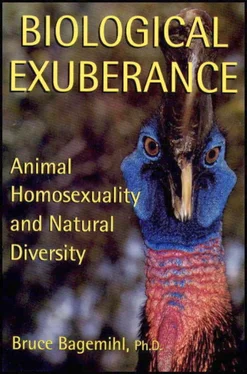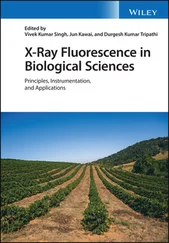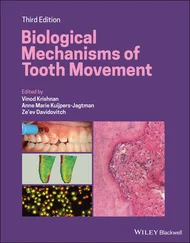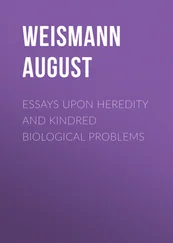In most instances where a physiological “explanation” is advocated, this is purely conjectural, not based on any actual hormonal studies of the animals involved, and often highly improbable on independent grounds. For example, the connection between male fetal hormones and a pregnant mother’s behavior—advocated as an “explanation” for mounting among female Takhi—is entirely speculative, since endocrinological profiles were not drawn up for the specific individuals involved in same-sex activity. Moreover, even if there were a connection, it would be at most only a partial explanation for this (and other) species. One Takhi mare mounted males when carrying a male fetus rather than mounting other females and also failed to show similar behavior the next year when she was again pregnant with a male fetus. 114Thus, additional factors must be involved in determining whether such mares participate in homosexual, bisexual, and/or heterosexual (reverse) mounting behavior, if any of these. More generally, this explanation does not have wide applicability to other species. For example, only a fraction of Domestic Horses (which are closely related to Takhi) ever show mounting behavior of any sort when pregnant. 115In addition, homosexual behavior by pregnant females occurs in less than 8 percent of all mammals in which female homosexual mounting has been documented, and in none of these species is the behavior exclusive to pregnant females (or to pregnant females carrying male fetuses). A fetal hormonal “explanation” is irrelevant, as well, for huge segments of homosexual activity, such as same-sex behaviors in animals that do not get pregnant (males of virtually all species and females of egg-laying species, for example).
In addition to being empirically unfounded, physiological explanations are also suspect on conceptual grounds. Almost without exception, hormonal or other pathological accounts of homosexuality focus on the animal exhibiting “gender-atypical” behavior, e.g., the male being mounted or the female doing the mounting. The partners of these individuals are usually considered to be physically “normal” animals whose behavior warrants no further consideration. Yet in many cases the “gender-conforming” partners are equally active participants in homosexual activity, sometimes even initiating same—sex interactions. As we saw in the discussion of “pseudoheterosexual” explanations, this categorization of animals into gender-conforming versus nonconforming, or “truly homosexual” versus “not-quite-homosexual” individuals, is in most cases arbitrary. It reflects not so much any inherent qualities or meaningful behavioral attributes in the animals themselves, but rather the observer’s biases or conceptual categories. 116
The pathologizing of “gender-atypical” behavior is taken to its extreme in the discussion of transgendered animals. Early descriptions of intersexual animals of ten labeled them “monstrosities.” 117More recently, hermaphroditism, chromosomal and other forms of gender mixing, and physical and behavioral transvestism are invariably considered diseased states, birth defects, physiological abnormalities, or otherwise dysfunctional. Yet researchers have usually been as unsuccessful in determining the physical “causes” for transgender as they have for homosexuality. For example, in discussing what they call “effeminate” behavior in Bighorn rams (males who exhibit some of the behavioral and social characteristics of females), scientists have tried to appeal to hormonal factors. Yet they were forced to conclude that this is an unsatisfactory explanation, since such males are physically “normal” and differ from other rams only in their behavior. The entire discourse surrounding transgender in White-tailed Deer centers on describing this as a “pathological condition” and attempting to find its physiological source. Velvet-horns (gender-mixing male deer) in Texas were subjected to a comprehensive battery of tests, including sampling and dissection of their sex organs to look for infection or “anomalies,” blood tests for possible microorganisms or contaminants, dietary profiles, hormone injections, and chromosomal studies, none of which turned up any “cause.” Investigators finally concluded that this “condition” must be due to a naturally occurring toxin in the soil where the animals live, yet admitted that no specific substance that might have this effect could be pinpointed or isolated in the animals’ environment. Similarly, a gender-mixing Savanna (Chacma) Baboon in South Africa was shot and dissected to “study” its reproductive organs. Another was captured and given hormone “treatments” to see if it would behave like a “normal” female (defined, in this case, as participation in heterosexual intercourse with a male). Investigators stated that this individual could have been a “successful female in the wild” if only it had “normal functioning ovaries.” 118
These cases highlight one of the primary reasons that transgendered animals are usually considered abnormal: they often cannot (or do not) reproduce. Yet this is a limited and erroneous definition of “normalcy” that overlooks crucial facts about the lives of transgendered (and nontransgendered) animals. For one thing, transgendered animals arise “spontaneously” and repeatedly in natural populations, and they do survive successfully in the wild. Gender-mixing Baboons similar to the one given hormonal treatments have been observed in the same area of South Africa as far back as the early 1900s and are probably a regularly occurring feature of this and other populations. Moreover, such individuals are fully integrated members of their troops and may even assume high-ranking or “leadership” positions. The truth is, the gender-mixing individual described above (and others like it) was able to survive and even prosper without “normal functioning ovaries.” Similarly, velvet-horns have been reported in a wide range of geographic areas and at least as far back as 1910–20, again indicating a long-standing, regular feature of natural Deer populations. 119Although such individuals are sometimes “ostracized” by other Deer, they have developed their own forms of social organization, living in distinct “communities” with unique behavior patterns.
Conversely, many nontransgendered animals fail to participate in reproduction and may in fact never successfully procreate during their entire lives (numerous examples will be discussed in the next chapter). If failure to reproduce were sufficient grounds to exclude an individual from “normalcy,” the majority of animals in some populations and species would not make the roster. In contrast, many transgendered animals do reproduce, such as intersexual Bears and gender-mixing female White-tailed Deer, and may in fact be more heterosexually successful than nontransgendered animals (as in transvestite Northern Elephant Seals, Red Deer, Black-headed Gulls, and Common Garter Snakes 120). The final irony is that nonbreeding animals (including transgendered individuals) are also sometimes more healthy than breeders, precisely because they do not reproduce. Velvet-horn White-tailed Deer, for instance, are generally in much better physical condition than breeding males because they do not undergo the extreme physical rigors of the rutting season, which often cause severe weight loss and may even stunt growth in young bucks. Likewise, the mortality rate of breeding Bighorn rams is nearly six times higher than that of nonbreeding males. Clearly, then, participation in reproduction can be a liability rather than an asset to an individual’s survival and success.
The vehement pathologizing of transgender encapsulates the entire discussion surrounding the “cause” of alternate sexual and gender expression in animals. Phenomena such as homosexuality or gender mixing are never seen as neutral or expected variations along a sexual and gender continuum (or continua), but rather as abnormal or exceptional conditions that require explanation. At the root of this perception is the idea that homosexuality and transgender are dysfunctional behaviors or conditions because they do not lead to reproduction. In the next chapter, we’ll explore in greater detail the role of procreation in the animal kingdom and its complex interrelationships with homosexuality, bisexuality, transgender, and heterosexuality. Some of our most fundamental assumptions regarding the significance of reproduction must be revised as we come to understand the often surprising ways that animals structure their breeding and nonbreeding lives.
Читать дальше












